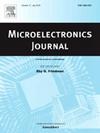w波段宽带高增益圆极化叠加寄生贴片π形天线阵列
IF 1.9
3区 工程技术
Q3 ENGINEERING, ELECTRICAL & ELECTRONIC
引用次数: 0
摘要
本文提出了一种w波段圆极化(CP)天线,该天线具有孔径耦合旋转π形贴片和叠加寄生贴片。本设计采用一对对称π形贴片,其优化的旋转角度可以实现高质量的圆偏振。与传统的偶极子或矩形贴片结构相比,π形结构提供了更高的轴向比(AR)带宽。辐射片嵌入在基片集成波导(SIW)形成的腔内,能量耦合通过SIW接平面上精确设计的插槽实现。为了进一步提高辐射性能,在辐射结构上方引入一对堆叠的矩形寄生片。仿真结果表明,该天线单元实现了11.7% (86-97 GHz)的AR带宽和9.7 dBic的峰值增益。作为概念验证,使用单层PCB技术设计和制造了一个2 × 2元件的原型。测量结果表明,该阵列阻抗带宽为11.4% (88 ~ 98.5 GHz), AR带宽为11.3% (87.2 ~ 97.6 GHz),增益变化范围为13.8 ~ 15.2 dBic,最大孔径效率为74.5%。本文章由计算机程序翻译,如有差异,请以英文原文为准。
W-band wideband high-gain circularly polarized π-shaped antenna array with stacked parasitic patches
This paper presents a W-band circularly polarized (CP) antenna featuring aperture-coupled rotating π-shaped patches and stacked parasitic patches. The design employs a pair of symmetrical π-shaped patches, whose optimized rotation angle enables the realization of high-quality circular polarization. Compared to conventional dipole or rectangular patch structures, the π-shaped configuration provides an enhanced axial ratio (AR) bandwidth. The radiating patches are embedded within a cavity formed by substrate-integrated waveguides (SIW), with energy coupling achieved through a precisely designed slot on the SIW ground plane. To further enhance the radiation performance, a pair of stacked rectangular parasitic patches are introduced above the radiating structure. Simulation results demonstrate that the proposed antenna element achieves an 11.7 % (86–97 GHz) AR bandwidth and a peak gain of 9.7 dBic. As proof of concept, a 2 × 2 elements prototype was designed and fabricated using single-layer PCB technology. Measurements demonstrate that this array exhibits an impedance bandwidth of 11.4 % (88–98.5 GHz), an AR bandwidth of 11.3 % from 87.2 to 97.6 GHz, a gain variation between 13.8 and 15.2 dBic, and the maximum aperture efficiency reaches 74.5 %.
求助全文
通过发布文献求助,成功后即可免费获取论文全文。
去求助
来源期刊

Microelectronics Journal
工程技术-工程:电子与电气
CiteScore
4.00
自引率
27.30%
发文量
222
审稿时长
43 days
期刊介绍:
Published since 1969, the Microelectronics Journal is an international forum for the dissemination of research and applications of microelectronic systems, circuits, and emerging technologies. Papers published in the Microelectronics Journal have undergone peer review to ensure originality, relevance, and timeliness. The journal thus provides a worldwide, regular, and comprehensive update on microelectronic circuits and systems.
The Microelectronics Journal invites papers describing significant research and applications in all of the areas listed below. Comprehensive review/survey papers covering recent developments will also be considered. The Microelectronics Journal covers circuits and systems. This topic includes but is not limited to: Analog, digital, mixed, and RF circuits and related design methodologies; Logic, architectural, and system level synthesis; Testing, design for testability, built-in self-test; Area, power, and thermal analysis and design; Mixed-domain simulation and design; Embedded systems; Non-von Neumann computing and related technologies and circuits; Design and test of high complexity systems integration; SoC, NoC, SIP, and NIP design and test; 3-D integration design and analysis; Emerging device technologies and circuits, such as FinFETs, SETs, spintronics, SFQ, MTJ, etc.
Application aspects such as signal and image processing including circuits for cryptography, sensors, and actuators including sensor networks, reliability and quality issues, and economic models are also welcome.
 求助内容:
求助内容: 应助结果提醒方式:
应助结果提醒方式:


